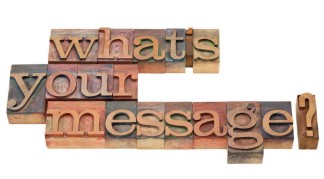This is the final post in my six part series on The Strategy of Answering Questions. My previous post talked about how the toughest of questions can provide great opportunities to get your messages across.
But as you may recall from our example, we never developed messages. We had several bullet points, but no real messaging surrounding the launch of our sample product or service:
- Last several years developing, testing and refining new technology
- Enables consumers to accomplish tasks faster and more efficiently
- Target audience are men and women 35-54 years old; educated; high disposable income
- Vastly improves existing technology
To get from bullet points to actual compelling messages, do the following:
- Pick out the key messages, objectives, or points you want to make. Odds are your bullets can be categorized into three or four messages.
- Prepare a mini-speech; a headline followed by an example, for each message. The headline is your message stated in the strongest possible language. The example is the way to prove your headline. There are four types of examples you can use:
- personal experience
- experiences of others
- facts/statistics
- analogies
Whenever possible, have several examples that support and reinforce your headline. Doing so allows you to repeat your headline without going back to your only proof point. The person you are meeting with may not remember all of your specific examples, but the headline becomes memorable. I don’t recall one “light” or “bridge” but I sure do remember “A thousand points of light” and “Building bridges.”
- Think of the questions a reporter might ask you during an interview.
- Decide the best possible response to each question and then determine whether you can bridge from that answer to one of your objectives. (Use the three-column technique.)
- If you can bridge, state your message in the form of your prepared mini-speech. If you can’t, either state your answer and wait for the next question or say, “I don’t know.”
Other things to remember:
-
Avoid over-answering the question. Give a direct response to each question in as few words as possible and then bridge, if you can.
- There is no such thing as “off the record.” We say this for interviews, but it is important for all business meetings.
- Nodding. People often nod inadvertently to show they understand the question. They’ve heard the question before, and/or they’re ready to answer the question. Unfortunately, nodding also suggests agreement with statements, and that may give a false impression.
- Labeling the question. Refrain from such expressions as “That’s a good question,” or “I’m glad you asked that.” Those phrases buy time but they can be irritating.
- Competitive questions. Be especially careful about questions involving proprietary topics. You can discuss the issues but you don’t have to discuss your strategies.
- Avoid jargon. Think in terms of simple language understandable to a larger audience.
- Energy level. Keep it up, up, up. Higher energy level translates into increased credibility and believability.
- Pick your battles. Stick to your prepared messages.
- Go back to your messages. Often the last question is “Do you have anything to add?” Use this question as the opportunity to reemphasize your message points.





